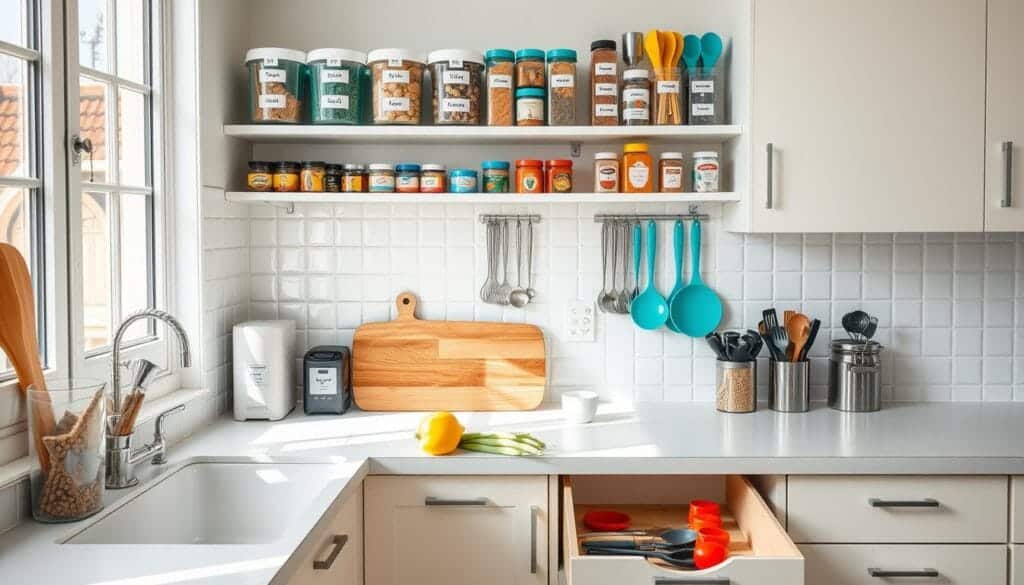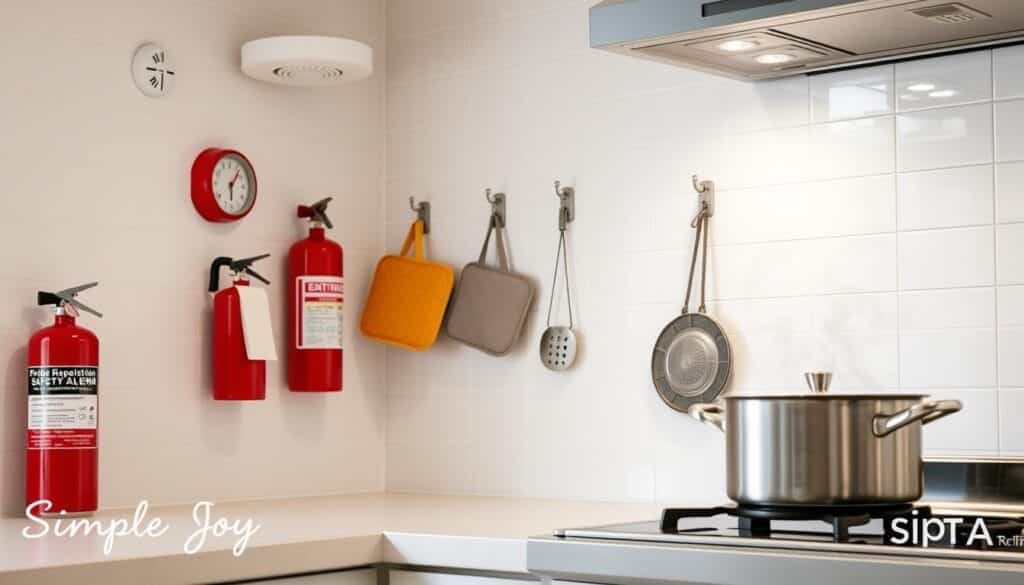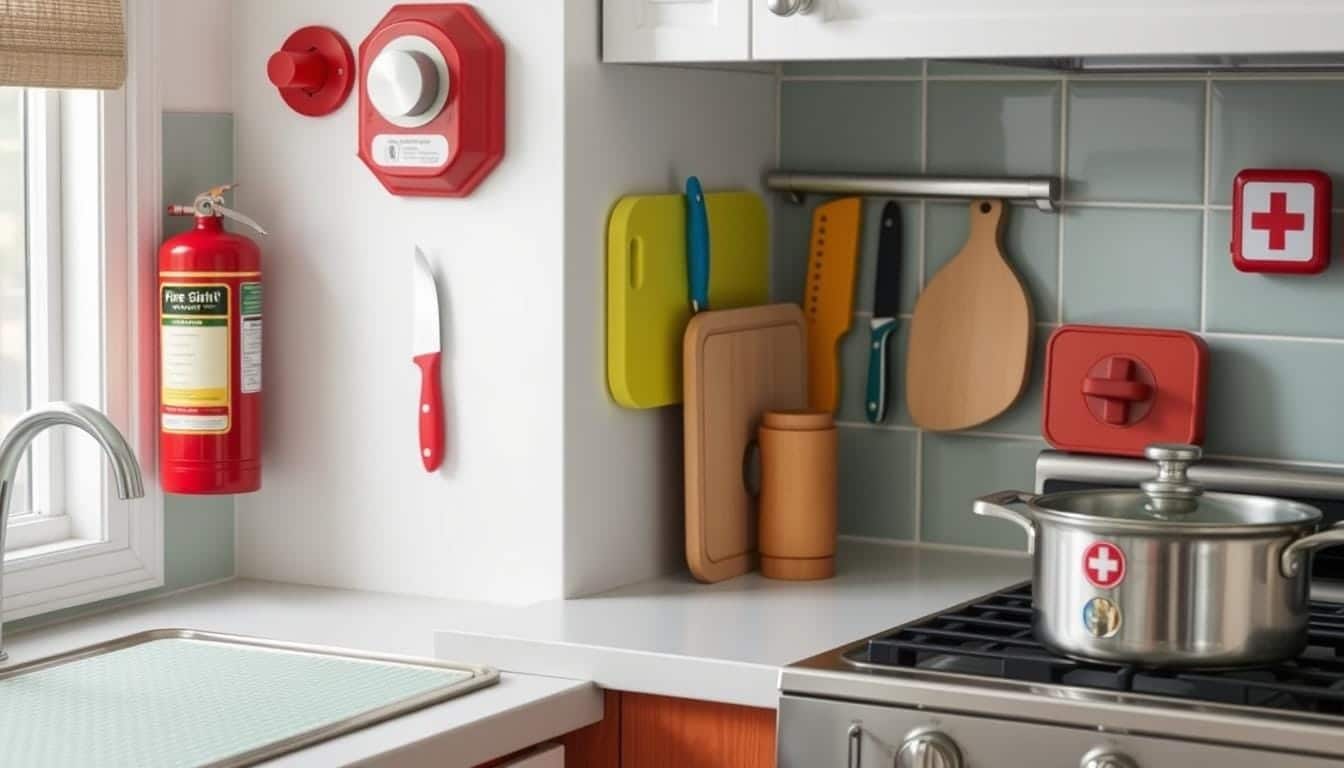As a passionate home chef, I’ve learned that the kitchen can be a sanctuary for culinary creativity. But, it can also harbor hidden dangers. I’ve seen family and friends fall victim to common kitchen accidents, from scalding burns to nasty cuts.
That’s why I’m here to share a comprehensive guide on kitchen safety tips. These tips can help you avoid these pitfalls and maintain a secure cooking environment.
Whether you’re a seasoned cook or a novice in the kitchen, this article will provide you with the essential knowledge. We’ll cover everything from preventing fires and burns to ensuring proper food handling. These safety measures can make all the difference in your culinary adventures.
So, let’s embark on this journey together. We’ll uncover the secrets to a safe kitchen. This will allow you to confidently and joyfully prepare delicious meals without the constant worry of accidents. Get ready to master the art of kitchen safety and unlock a new level of culinary confidence!
Table of Contents
Establish a Safe Kitchen Environment
Creating a safe kitchen starts with decluttering and organizing. Clear countertops, drawers, and cabinets of clutter. This prevents tripping hazards and makes tools and equipment easier to find.
Decluttering and Organization
Go through your kitchen to find areas that need tidying. Get rid of items you don’t use anymore. Use storage solutions to keep your most used items within reach. Proper kitchen organization improves safety, boosts productivity, and makes cooking more fun.
Proper Lighting and Ventilation
Good lighting and ventilation are key for a safe kitchen. Make sure your work surfaces are well-lit to avoid accidents. Also, proper ventilation removes smoke, steam, and odors, reducing respiratory risks and fire hazards.
| Kitchen Organization Tips | Lighting and Ventilation Recommendations |
|---|---|
|
|

“A well-organized kitchen not only looks clean and tidy, but it also promotes safety by reducing the risk of accidents and making it easier to access the tools you need.”
Prevent Fires and Burns
Kitchens are busy places but can be dangerous if safety steps aren’t followed. It’s key to have safe cooking practices to keep your kitchen safe.
Safe Cooking Practices
To stop kitchen fires, keep flammable things like towels and paper away from heat. Always watch the cooking and don’t leave the kitchen when cooking. Wearing aprons and closed-toe shoes helps protect against burns.
Handling Hot Liquids and Surfaces
Be careful with hot liquids and surfaces to avoid burns. Always use oven mitts or potholders for hot items. Don’t stretch over the stove and watch where you put your hands to avoid hot surfaces. Clean spills fast to lower burn risks.
| Safe Cooking Practices | Handling Hot Liquids and Surfaces |
|---|---|
|
|

“An ounce of prevention is worth a pound of cure when it comes to kitchen safety.”
By sticking to safe cooking practices and watching out for hot liquids and surfaces, you can lower kitchen fires and serious burns risks. Making fire hazards and burn prevention a priority is vital for a safe kitchen.
Knife Safety and Cutting Techniques
Knives are key in any kitchen, but they can be dangerous if mishandled. Learning knife safety and cutting skills is vital for a safe and efficient cooking process.
First, always choose the right knife for the task. Each knife is made for a specific job. Using the wrong one can lead to accidents. Also, sharp knives are safer than dull ones. Dull blades need more force, which can cause slips and cuts.
- Maintain a stable work surface: Cutting on a stable, non-slip surface is key to preventing accidents. Avoid cutting on wobbly or uneven surfaces.
- Keep your fingers tucked: When cutting, curl your fingers under and keep your knuckles close to the blade. This helps protect your fingertips from the sharp edge.
- Use a proper grip: Grip the knife handle firmly with your dominant hand, with your thumb and index finger gently pressing against the blade.
- Cut away from your body: Always cut away from your body, keeping the knife pointed in a safe direction.
- Pay attention: Stay focused and alert when using a knife. Avoid distractions that can lead to accidents.
Learning the right cutting techniques makes you more efficient and safe in the kitchen. Techniques like the rock chop, the push cut, and the slice help with tasks like dicing vegetables or slicing meat.
“Proper knife skills are not only about safety, but also about efficiency and precision in the kitchen.”
By mastering knife safety and cutting techniques, you can have a safer and more productive cooking experience. Remember, a little practice and attention to detail can prevent kitchen accidents.
Food Poisoning Prevention
Keeping food safe is key in the kitchen to avoid foodborne illnesses. By handling and cooking food right, you can lower the risk of getting sick. Here are the main steps to ensure a safe and healthy meal.
Proper Food Handling
Proper food handling is the first defense against food poisoning. Begin by washing your hands well with soap and water before and after touching raw ingredients. Also, clean all surfaces, utensils, and cutting boards that touch food. This stops harmful bacteria from spreading.
Cooking Temperatures
Cooking food to the right temperature is vital to kill harmful germs. Use a food thermometer to check the internal temperature of meat, poultry, and seafood. Here are the safe temperatures:
- Beef, pork, lamb, and veal: 145°F (63°C)
- Ground meats: 160°F (71°C)
- Poultry: 165°F (74°C)
- Fish and seafood: 145°F (63°C)
By following these guidelines, you can safely cook and enjoy your meals.
“Proper food handling and cooking temperatures are the keys to preventing food poisoning in the kitchen.”
Kitchen Safety Tips: Avoid Common Accidents
Safety is key in the kitchen. A few simple tips can help avoid accidents and keep you and your family safe. Here are some important tips for a safe cooking space.
Prevent Slip and Fall Incidents
Slips and falls are common in kitchens. Make sure your floors are clean and dry. Clean up spills quickly and use non-slip mats or rugs where needed.
Manage Knife Safety
Handling knives safely is important. Always cut on a stable surface and keep knives sharp. Use the right knife for the job and store them safely when not in use.
Beware of Burn Hazards
Burns are a common kitchen risk, but you can prevent them. Keep flammable items away from heat. Use caution with hot liquids and surfaces. Always wear oven mitts and watch out for splattering oil or steam.
Prevent Food Poisoning
Good food safety practices can prevent illnesses. Wash your hands and clean surfaces well. Make sure food is cooked at the right temperature. Refrigerate perishable items quickly to stop bacteria growth.
By following these kitchen safety tips, you can make your kitchen safer. Taking these steps helps keep you and your family safe while cooking. Enjoy a safe and enjoyable cooking experience.
Slip and Fall Prevention
Slips and falls are common in kitchens and can cause serious injuries. You can take steps to lower the risk of these accidents. Keep your kitchen floors clean and dry, clean up spills quickly, and use non-slip flooring and mats. This will make your kitchen safer for you and your family.
Cleaning Spills Promptly
Spills on kitchen floors can quickly become a hazard. It’s important to clean up spills right away. Keep a mop, paper towels, and cleaning solution handy to quickly clean up spills. Also, make sure your kitchen floors are dry before you start doing things again.
Non-Slip Flooring and Mats
Using non-slip flooring or mats can greatly reduce the risk of slips and falls. Look for flooring with a textured or rough surface, like tile or rubber-backed rugs. Place non-slip mats in busy areas, like in front of the sink or stove, to make your kitchen safer.
| Type of Flooring | Slip Resistance | Maintenance |
|---|---|---|
| Tile | High | Easy to clean and maintain |
| Vinyl | Moderate | Low maintenance, easy to clean |
| Hardwood | Low | Requires regular cleaning and polishing |
By following these slip and fall prevention tips, you can make your kitchen safer. A little effort can prevent dangerous accidents.
Child Safety in the Kitchen
When kids are in the kitchen, their safety is key. It’s important to watch them closely and give them tasks that fit their age. This way, they can help with cooking safely.
Supervision and Age-Appropriate Tasks
Always keep an eye on kids in the kitchen. Be close enough to help if needed. Give them tasks that are right for their age and skill level.
- Young kids can do simple things like mixing or setting the table.
- As they get older, they can measure, pour, and use safe utensils.
- Teenagers can help with more tasks, like washing veggies, but always watch them.
By balancing supervision and tasks, you make the kitchen a safe and fun place for kids. It helps them learn important skills and stay safe.
| Age Range | Appropriate Kitchen Tasks |
|---|---|
| 3-5 years |
|
| 6-8 years |
|
| 9-12 years |
|
By watching them and giving them the right tasks, you make the kitchen a safe and fun place for kids. It’s where they can learn and explore cooking.
First Aid and Emergency Preparedness
Accidents can happen in the kitchen, even when we try to prevent them. Being ready with basic first aid and an emergency kit is crucial. It helps you handle minor cuts and big emergencies like fires.
Mastering First Aid Essentials
Learn the basics of first aid for common kitchen injuries. Knowing how to clean and bandage wounds, treat burns, and handle choking is key. Make sure you know these skills and have the right supplies ready.
Assembling an Emergency Kit
Have a first aid kit in your kitchen with essentials like bandages and antiseptic wipes. Also, include fire extinguishers, emergency numbers, and a plan for leaving your home quickly if needed.
| First Aid Kit Essentials | Emergency Preparedness Items |
|---|---|
|
|
Focus on first aid and emergency preparedness in your kitchen. This way, you’ll be ready for any situation. Building your knowledge and gathering the right tools will give you peace of mind and keep your family safe.
Electrical and Appliance Safety
In today’s kitchens, electrical appliances are key but also risky. It’s vital to use and maintain them right to avoid accidents and electrical dangers.
Proper Use and Maintenance
To keep your kitchen safe and your appliances working well, follow these tips:
- Always read and follow the manufacturer’s instructions for each appliance.
- Don’t overload electrical outlets, as it can cause fires and power surges.
- Check cords and plugs for damage like fraying or cracks, and replace them if needed.
- Clean appliances as recommended by the manufacturer to avoid fire hazards from dirt and grease.
- Make sure all electrical appliances are grounded to lower the risk of electrical shocks.
- Think about updating older appliances with outdated electrical parts to safer models.
By focusing on electrical safety and appliance maintenance, you make your kitchen safer and more efficient. Regular checks and proper use of your kitchen gear are simple steps to boost appliance safety and prevent hazards.
“Proper use and maintenance of kitchen appliances is essential for ensuring a safe and efficient cooking environment.”
Conclusion
In conclusion, following these kitchen safety tips can help you avoid accidents. It keeps your cooking space safe. This way, you can enjoy cooking without worrying about safety.
Setting up a safe kitchen layout is key. It helps prevent fires and burns. Learning to use knives well and handling hot items carefully are also important.
Kitchen safety is about more than just protecting yourself. It’s about making a space where you can cook freely. By following these tips, you’re making your cooking experience safer and more fun.
FAQ
What are some tips for establishing a safe kitchen environment?
To make your kitchen safe, start by decluttering and organizing. This helps avoid tripping hazards. Make sure there’s enough light and good air flow for clear visibility and health while cooking.
How can I prevent fires and burns in the kitchen?
To avoid fires and burns, cook safely. Keep flammable items away from heat and watch cooking temperatures. Wear protective clothes and be careful with hot liquids and surfaces.
What are the best practices for knife safety and cutting techniques?
Learn safe knife handling. Cut on a stable surface, keep fingers tucked, and use the right knife. This helps prevent accidents and injuries when using knives.
How can I prevent food poisoning in the kitchen?
To stop food poisoning, handle food safely. Wash hands, surfaces, and utensils often. Cook food to the right temperature to kill bacteria.
What steps can I take to prevent slips and falls in the kitchen?
Keep floors clean and dry. Clean up spills quickly. Use non-slip flooring and mats to prevent slips and falls.
How can I ensure child safety in the kitchen?
Always watch children in the kitchen. Give them tasks that fit their age. This keeps them safe while they help with cooking.
What first aid and emergency preparedness measures should I have in place?
Learn basic first aid and have a first aid kit ready. Be ready for emergencies like kitchen fires or other dangers.
How can I ensure electrical and appliance safety in the kitchen?
Use and maintain appliances safely to avoid electrical hazards. Follow the maker’s instructions for safe use of your kitchen equipment.

